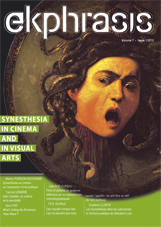Le Kitsch comme art du désespoir dans le cinéma de Rainer Werner Fassbinder (Les larmes amères de Petra von Kant)
The Kitsch as Art of Despair in the Cinema of Rainer Werner Fassbinder (The bitter tears of Petra von Kant)
Author(s): Elena TjushovaSubject(s): Theatre, Dance, Performing Arts
Published by: Universitatea Babeş-Bolyai, Facultatea de Teatru si Televiziune
Keywords: kitsch; “the art of happiness”; Rainer Werner Fassbinder; painting; opera; melodrama; theatre; sculpture; alienation; violence
Summary/Abstract: I establish my study on basically two theorists of Fassbinder’s aesthetics, the analysis of the kitsch in Fassbinder’s films by Françoise Dahringer and the articles on painting and music in his films by Vivien Villani. Then I take the idea of Abraham Moles, that Kitsch is “the art of happiness” and I use it to analyse a six minutes sequence in The bitter tears of Petra von Kant. Thereby, I show that Fassbinder’s film aesthetic is synesthetic. It is a superposition of kitsch objects, objects that provide happiness, which combine in a very unique way opera, painting, cinema and theatre. But in the case of Fassbinder, the kitsch does not provide happiness. My theory on kitsch as art of despair comes from Fassbinder’s theatre influences (Bertolt Brecht and Antonin Artaud). This film shows both the techniques of the theory of alienation and the “theatre of cruelty”. The first one adds a dimension of irony and the second adds the theatrical violence, which is exaggerated and spectacular. Both of these techniques create an alienation of the spectator. Whereby, the Kitsch becomes the art of despair.
Journal: Ekphrasis. Images, Cinema, Theory, Media
- Issue Year: 07/2012
- Issue No: 1
- Page Range: 99-110
- Page Count: 12
- Language: French

